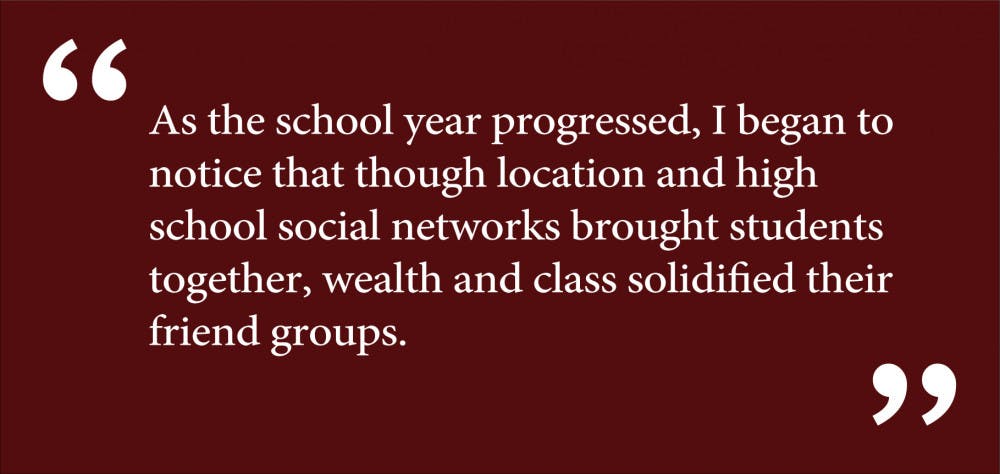On my freshman year move-in day, I found myself with nothing to do. My parents had left and gone back home, my roommate hadn’t yet moved in and I was hungry for dinner. My texts revealed a few options: hit the Sharpe Refectory (as I knew it to be named at the time) with my two friends from ADOCH, wait for my roommate to arrive or get dinner with a couple of New York City kids whom I tangentially knew. Though I didn’t realize it at the time, this NYC dinner offer was actually the beginning of a rapidly forming clique of students who were all connected through various Manhattan social networks. Similar groups of students from Washington, D.C., the Bay Area and various suburbs were doing the same thing. In all these cases, they’d either gone to high school together, played each other in sports, had parents who worked together or, in my situation, lived in the same building as each other.
As the school year progressed, I began to notice that though location and high school social networks brought students together, wealth and class solidified their friend groups. Brown students are on average undeniably wealthy, with more students coming from the top 1 percent of the income scale than the entire bottom 60 percent. Not only is this unrepresentative of the wider population as a whole, but even more distressing is that these students tend to immediately befriend each other and stick together.
While Brown tries its best to create a diverse student body, it’s really up to the students to take advantage of it and break out of their own social bubbles. College was the first time I had friends my age who didn’t grow up in the Northeast, who grew up in the suburbs and could drive and, truth be told, it was the first time I had friends who were completely outside of my parents’ income bracket.
I didn’t realize how sheltered I’d been in this regard before I came to Brown. Here, I met students whose parents owned islands they could go to over spring break. I also met students for whom it was a challenge to get home for Thanksgiving or even winter break. One friend of mine told me her mom had never gotten to visit Brown. This surprised me at the time — my parents had come with me to visit plenty of schools I didn’t even end up applying to. My friend was really excited when she got a job as a grader that made her enough money to pay for her mom’s airfare. Being able to do that, she said, was such a joy.
As students, we can actively work to bridge the divide and expand our social circles beyond those who come from our own income bracket. At least as first years, we all eat in the Ratty and live in the same dorms, no matter our wealth. Though it can be easy for wealthy people to eat off campus, there’s a greater variety of people in the dining hall. Taking advantage of these common spaces presents the opportunity to meet other students who come from different backgrounds.
In addition, befriending students in socioeconomic classes different than my own made me much more aware of the range of wealth that exists both within Brown and beyond. Having friends of diverse wealth is an experience that simply can’t be overlooked.
In some respects, Brown can be a social equalizer. When we graduate, we will all be a part of an elite group of Brown alums, and we can tap into the connections we can offer to one another, regardless of our socioeconomic background.
It makes sense that people want to stick with those who are in the same income bracket and share similar experiences. I see myself doing this all the time out of sheer convenience. Something as simple as grabbing a meal can vary widely between friends who don’t have the same resources, and everyday activities like this often dictate who you spend the most time with. Naturally, people want to engage with those they feel comfortable around, which includes avoiding issues of wealth differences. It’s also completely understandable that students don’t want to hang out with vastly wealthier students because they feel out of place. But the point of college is not to stick to the social groups you have always known. It’s on those wealthier students to be more accommodating. And as a University, Brown has done a pretty good job of trying to level the playing field by taking actions such as eliminating the suite fee, providing loaner Mac laptops (along with PCs) and encouraging professors to scan readings so students need not buy as many books, to name just a few. There are many more things Brown can and should do, but much of the work in embracing the diversity that exists here at Brown lies with the students.
In her commencement address last spring, President Christina Paxson P’19 urged Brown students to take what they’d learned from Brown and “live courageously.” I believe we should exercise that while at Brown. To live courageously to me means stepping outside of our comfort zones. It means confronting our differences, even when they can cause things to get awkward. It means befriending people we wouldn’t otherwise have the opportunity to meet. By doing that, we’ll get the most out of our college experience.
Lena Renshaw ’20 can be reached at lena_renshaw@brown.edu. Please send responses to this opinion to letters@browndailyherald.com and other op-eds to opinions@browndailyherald.com.





